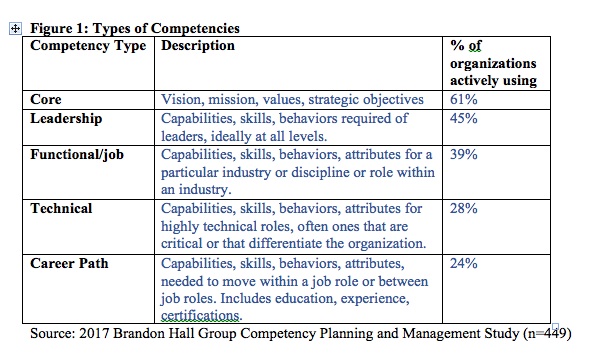
As organizations try to improve their abilities to engage, develop, and retain high-quality employees and improve business outcomes, competencies can be a powerful tool.
Competencies—the knowledge, skills, abilities, and behaviors to successfully perform a job or job role—can serve as the foundation for most or all talent process. They can help:
- Define hiring criteria for high-quality job candidates
- Define goals for performance management
- Determine priorities for learning and development to improve individual and organizational capabilities
- Define goals and standards for leadership development
- Facilitate career and succession management
By creating a defined “playing field” for performance development, competencies create a clear and transparent blueprint for employee development from the time of hire, through the employee lifecycle.
However, Brandon Hall Group’s 2017 Competency Planning and Management Study shows that most organizations are barely scratching the surface of the potential that competencies represent:
- Almost two-thirds of organizations (64 percent) have no program, an ad-hoc approach, or are working to define competencies and a competency framework for mission-critical positions or job roles. This is the lowest level of maturity among Talent and Learning practices researched by Brandon Hall Group in the last 18 months.
- Only 8 percent of organizations say they have fully developed competencies aligned with business goals, along with a framework, job profiles, proficiency scales, and governance.
- Only 19 percent of organizations that utilize competencies say competencies and business goals are aligned.
Laying the Groundwork
Before delving into the challenges of competencies—and key strategies for improvement—it is important to understand what competencies are, the types of competencies, and ways to communicate the approach to competencies to the organization.
Competencies are the knowledge, skills, abilities, and behaviors to successfully perform a job or job role. There are several types of competencies, as shown in Figure 1 below. Only core competencies—the most basic type, which define vision, mission values, and strategic objectives of the organization—are actively used by the majority of organizations.

It’s important for organizations to develop an approach to competencies that fits the needs and business goals of the organization. This is often done through a competency framework, or model. It provides a high-level view of how the organization defines competencies (while the names and descriptions above are typical, they are not universal to all organizations) and how they work together.
A framework plays a big role in developing a common understanding and language around competencies. However, only 28 percent of organizations have a fully developed and active competency framework/model, which negatively affects the ability to create a common language and culture around competencies. This is one major reason most organizations struggle with competencies. The basics are not well enough established.
Figure 2: Example of Basic Competency Model
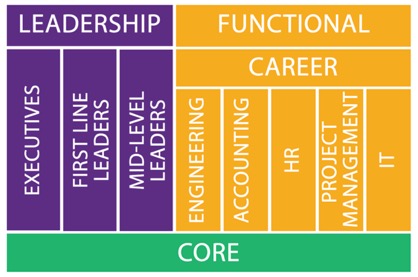
Source: Brandon Hall Group 2017
Competency Management Maturity and the Impact on Effectiveness
An organization’s ability to invest in competencies enough to develop different types of competencies in concert with each other, aligned with business objectives, enabled by technology, determines the maturity of their competency management practice. The research shows that the level of maturity determines the level of benefit—in terms of impact on key business indicators, as well as on other talent management practices.
To gauge how organizations are faring with competencies, Brandon Hall Group, using the research results, developed a Competency Maturity Model. It illustrates four levels of maturity, along with definitions of each level.
Figure 3: Brandon Hall Group Competency Maturity Model (download at end of article)
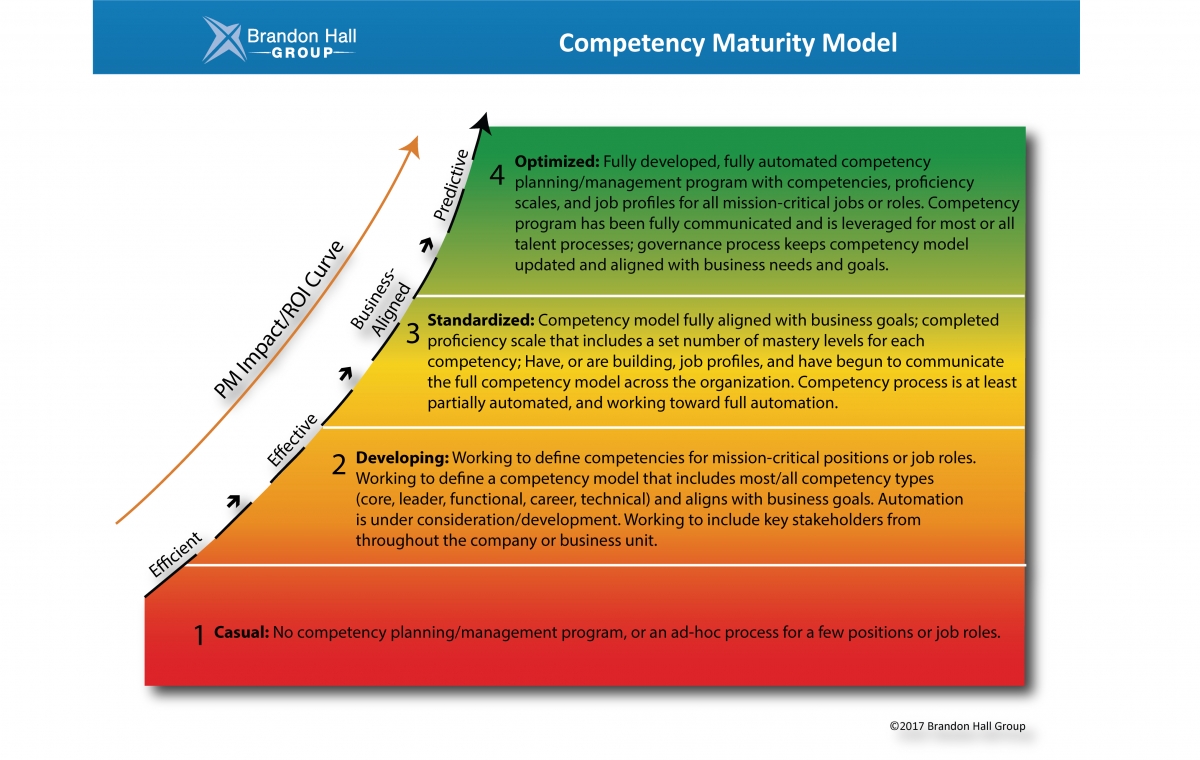
Source: Brandon Hall Group 2017
Brandon Hall Group develops maturity models for each of its research studies. The 64 percent of organizations at Levels 1 and Level 2 makes competency management the least mature of the Talent Management and Learning and Development practices in the last 18 months of research.
This represents a huge missed opportunity, because organizations with fully developed competency management programs have a significant impact on key business indicators. The relatively few organizations at Level 4 are:
- 55 percent more likely than other organizations to have increased revenue over the last year.
- 45 percent more likely to have increased customer retention over the last year.
- 41 percent more likely to have increased market penetration over the last year.
- 41 percent more likely to have increased customer satisfaction over the last year
- 37 percent more likely to have increased employee engagement over the last year.
With the potential impact so high, why are so few organizations able to take advantage?
There are several reasons for the relative lack of maturity of competency management. The big picture, according to our research, is that high-performance competency management is a complex process that requires:
- Executive buy-in and leadership
- Alignment of competencies with business goals
- Communication and transparency throughout the organization
- A common language and approach to competencies throughout the organization
- Organizations face several barriers to appropriately develop and manage competencies.
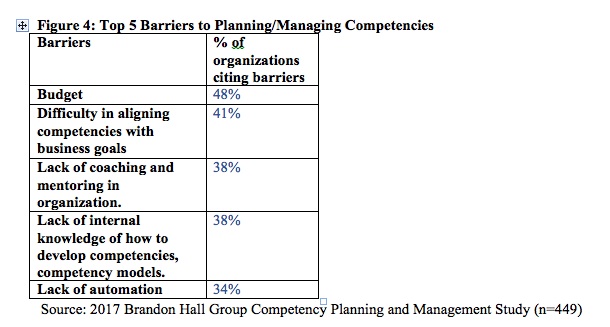
Organizations understand the value of competencies. A high percentage of respondents cited several excellent objectives, but the barriers create a large gap between objectives and effectiveness.
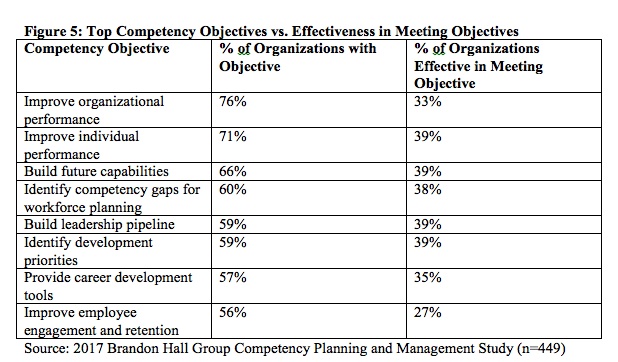
While competency development and management sits at a low maturity level and faces many barriers, there are several strategies for improvement that can be implemented—most of them straightforward and doable for organizations serious about the value of competencies.
The next section of the report identifies and describes those strategies for success in competency management.
4 Strategies for High-Performance Competency Management
1. Take time to develop planning tools. Developing and managing competencies is a complex process, especially for large and matrix organizations. These have thousands of employees with myriad skills, in multiple operating units, often spread across the globe.
It was stunning to discover in the research that 70 percent of organizations overall, and 64 percent of organizations just developing competencies (Levels 1 and 2), were attempting to utilize competencies for all full-time employees.
While that may be a laudable long-term goal for some organizations, Brandon Hall Group’s experience with companies attempting to establish competencies tells that us that it is better to start by establishing competencies for critical jobs and job roles. Even determining what is critical and not as critical can lead to lively debate within organizations. But the point is, as with most new initiatives, it is better to start small or launch a pilot program so you gain experience before expanding the scope.
The other issue is that the majority of organizations are going all-in on competencies without establishing and utilizing planning tools that can create a common competency language and culture. It is impossible to get competencies right if you are not using the same terminology, don’t have a governance structure, and aren’t utilizing tools such as job profiles, proficiency scales, and competency models. But that is exactly what is happening—less than one-third of organizations are fully active in utilizing critical competency planning tools.
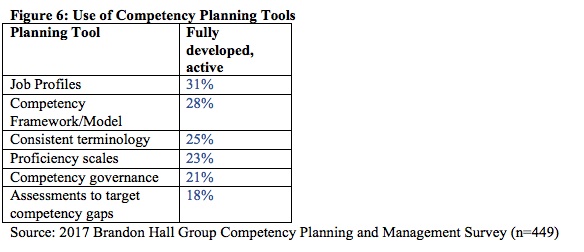
The key to success is to take the time to fully develop planning tools. For example, completing and utilizing a competency model/framework enables organizations to take a consistent, organized approach toward using competencies within the talent management lifecycle. Only 28 percent of organizations have a fully developed competency model. But those organizations that do tend to get much better results:
- Organizations with fully active frameworks are 58 percent more likely than other organizations to rate their top competency objectives as effective.
2. Align competencies to business goals. It is well-established that it is difficult for organizations to implement effective learning programs if the learning goals are not aligned to business goals. Yet, only 38 percent of organizations say that they have learning goals aligned to business goals, according to the 2016 Brandon Hall Group State of Learning and Development Study (n=433). The same thing is true for competencies—they must be aligned with business goals if they are going to be fully effective. The process for doing so can be slow and arduous. It involves collaboration among multiple stakeholder groups across business units and geographies. Therefore, the percentage of organizations able to do this is very low (19 percent), but the impact of doing so is high:
- Organizations with competencies aligned with business goals are 67 percent more likely than other organizations to rate their top competency objectives as effective.
3. Budget more money for competencies. Over the five-year period Brandon Hall Group has studied competency management, the function has been among the most underfunded of the talent management processes.
In 2013, on average, competencies accounted for 9 percent of the talent management budget and ranked eighth out of nine functions (workforce planning was last). In 2015, that number dropped to 7 percent on average, and again ranked next to last among talent management processes.
In 2017, we looked at competency management in terms of spending ranges and found that more than half of organizations spent 3 percent or less of their talent management budgets on competency management. One in five organizations spent nothing. But the more organizations invest in competencies, the better the results:
- Approximately one-quarter of organizations spend 10 percent or more of the talent management budget on competency management. They are 68 percent more likely than other organizations to rate their top competency objectives as effective.
4. Leverage technology to manage competencies. Given the low level of spending on competencies, it is not surprising that organizations have been much slower in utilizing technology to enable competency management than with other talent management processes. Some 40 percent of organizations still are paper-based when it comes to competency development, 49 percent are partially automated, and only 11 percent are fully automated.
Those with fully automated competency management are:
- 69 percent more likely than other organizations to rate their top competency objectives as effective.
- 55 percent more likely than partially automated organizations to rate their top competency objectives as effective.
Claude Werder is vice president or Research Operations and principal HCM analyst for Brandon Hall Group, an independent HCM research and analyst firm, with practices in Learning & Development, Talent Management, Leadership Development, Talent Acquisition, and Workforce Management/HR. Brandon Hall Group sponsors the HCM Excellence Awards and Technology Awards, and produces the Annual HCM Excellence Conference.




